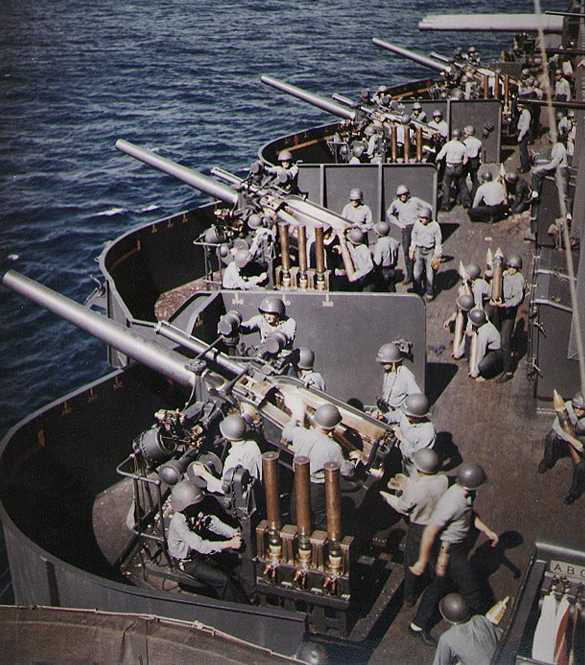|
The mountings for this weapon were lightly built in order to give them the lowest possible moment of inertia and thus the highest possible speeds for manual training and elevation. As a result, these guns had about one-third the moment of inertia for train as did the 5"/51 (12.7 cm) anti-torpedo boat mountings. This requirement led to a short barrel in order to keep the weight down, which in turn resulted in a relatively low muzzle velocity, but this was considered to be acceptable for an AAA weapon. In the early 1930s these guns were briefly considered for arming new construction destroyers, but they were ultimately rejected in favor of a new design, the famous 5"/38 (12.7 cm) Mark 12. On 15 February 1942 while escorting a convoy near Timor, USS Houston (CA-30) was attacked by nine Kawanishi H6K Type 97 ("Mavis") four-engine flying boats and thirty-six Mitsubishi Ki-21 Type 97 ("Sally") twin-engine bombers. Houston claimed to have shot down seven of these aircraft with her 5"/25 (12.7 cm) guns, firing a total of 930 rounds during the 45 minute action. All early models were constructed using a monobloc barrel. The prototype was a Mark 3 Mod 0 cut down to 25 calibers and then designated as Mark 3 Mod 3. The Mark 10 Mod 0 had an autofretted barrel with a threaded and shrunk-on housing and used a vertical semi-automatic sliding breech block. the Mark 10 Mod 1 used a threaded barrel keyed to the housing. Mark 10 Mod 3 had part of the left housing cut away to ease loading. The Mark 11 added chromium plating to the bore. Mark 13 was similar to the Mark 11, but the barrel and housing were joined by a bayonet joint to allow easy barrel replacement, a feature found in all subsequent US 5" (12.7 cm) designs. The Mark 17 was a "wet mount" version for submarines and was unusual in that it did not require breech or muzzle plugs. This was because it used a special liner resistant to corrosion from sea water and could thus be submerged and flooded without harm to the gun. The Mark 17 Mod 0 used a tube of higher strength steel than that used for earlier Marks and had a shrunk forged copper-nickel alloy liner. The Mark 17 Mod 1 was a bored out Mark 13 Mod 0 fitted with a tapered copper-nickel alloy liner. Both Mods of the Mark 17 had chrome-plated bores and lacked the pneumatic rammers used on other Marks. This was acceptable as the Mark 40 mounting used on submarines was an SP type with a maximum elevation of 40 degrees. |

5"/25 (12.7 cm) AA guns on USS New Mexico
BB-44 in June 1944
|
| .
|